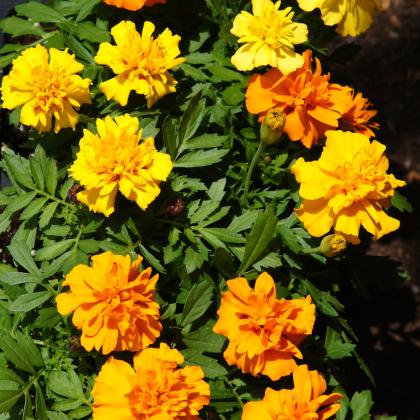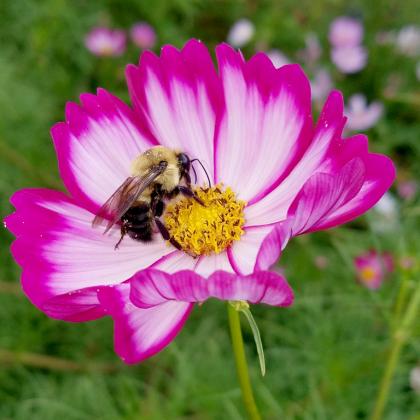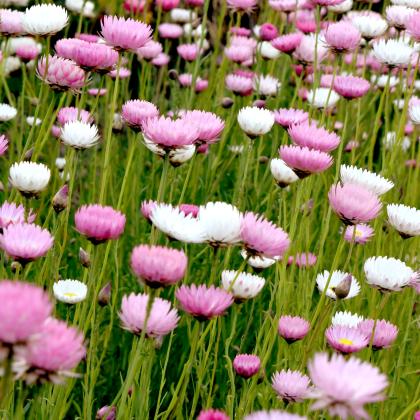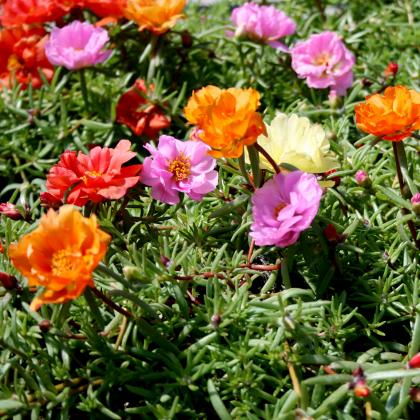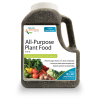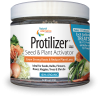Create a garden that can weather periods of little rain without sacrificing blooms.
Annuals provide garden cover and beauty for one year only, but typically dazzle with longer blooming periods perfect for hanging baskets and container gardens. Often, it is possible to harvest the seeds from your annual flowers for spring planting the following year. In container gardens and pots, maintaining proper drainage is especially important for annuals tolerant of drought and dry conditions. Place stones in the bottoms of containers to prevent roots from getting waterlogged and rotting. When transplanting or placing annuals, utilize Natural Alternative® 5-5-5 All Purpose Plant Food to ensure that your annuals have the nutrients needed to thrive all season long.
Marigolds
Native Areas: Southwestern U.S., Central and South America
Growth Rate: Moderate to fast
Feed: Only when planted
Sun: Full sun
Water: Weekly, after top two inches of soil dries out
Typically featuring orange and yellow flower heads, marigolds make a bold statement in a garden plan or on their own. Marigolds bloom throughout the growing season, usually dying after the first heavy fall frost. To encourage plentiful flowering, deadhead spent flowers. It is possible for marigolds to self-seed—if you're lucky, a seed from a previous season may germinate by itself after a mild winter. For more assured results, harvest marigold seeds throughout the season when petals are completely dry by removing the flower head and splitting it open. These seeds can be planted the following spring, after the last frost date has passed. Marigolds are a natural mosquito repellent and are featured in our mosquito repellent container garden for natural mosquito control.
Cosmos
Native Areas: Eastern U.S.
Growth Rate: Moderate
Feed: Only when planted
Sun: Full sun
Water: Weekly until established, then only when soil thoroughly dry
Multicolored and tall, cosmos are an exceptionally drought-tolerant annual that bring a wildflower-like appearance to a planted or container garden. When planting, allow some lateral room for cosmos to spread, as they will readily fill out a pot with foliage and flowers. Deadheading cosmos will encourage new growth, which occurs best in hotter climates. Combine cosmos with a shorter groundcover for a walkway garden or along sunny foundations.
Paper Daisy
Native Areas: California and Mexico
Growth Rate: Fast
Feed: Monthly
Sun: Full sun
Water: Weekly until established, then only when soil thoroughly dry
Paper daisies (helipterum) come in white and pink varieties, featuring tall stems and uniformly round blossoms. Cut paper daises adapt well to a vase, and are known to be an excellent choice for drying and preserving. Petals of paper daisy blooms may react to changes in weather, closing when sun is less available and reopening under sunnier conditions. Paper daisies are easy to sow from seed, and will die off after the first frost.
Foxglove
Native Areas: Mediterranean Europe
Growth Rate: Fast
Feed: Monthly
Sun: Full sun to partial shade
Water: Weekly, after top two inches of soil dries out
Foxglove straddles the line between an annual and perennial, being classified as a "biennial," essentially a short-lived perennial. Because of this, most gardeners treat foxglove as an annual and cross their fingers for a surprise second year of rebirth. Foxgloves are dramatic plants, with towering cones of purple, pink or white bell-shaped flowers. Their vibrant hues make them stars of walkways and larger gardens with ample vertical space for their tall stems. For hardy and sustained growth of these tall flowers, use Protilizer® Seed & Plant Activator monthly. When planting foxglove in a container, consider adding a low-lying or trailing complimentary plant for contrast, like vinca or ivy.
Moss Rose
Native Areas: South America
Growth Rate: Moderate
Feed: Only when planted
Sun: Full sun
Water: Weekly until established, then only when soil thoroughly dry
Moss rose is an excellent choice for the neglectful gardener, capable of thriving in dry and poor soil. Moss rose is a flowering succulent, so overwatering can easily kill this plant. Moss rose trails nicely, performing well in hanging baskets with sufficient sun. Drainage is especially important for moss rose—mixing sand and stones into your soil will help provide optimal growing conditions. Moss rose will provide bright and colorful blooms throughout the summer but will die quickly as temperatures cool in the fall.
